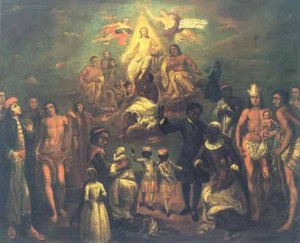I love using visuals when teaching. There are some standard images that are always successful teaching tools, like
Paul Revere’s engraving of the Boston Massacre or
notorious images of African slaves packed into a ship during the Middle Passage. “A picture is worth a thousand words” is a cliché because it is, of course, true, and images offer students an opportunity to discuss the shaping of political opinion and Revolutionary sentiment (in Revere’s case) or the connections between race, science, and capitalism (in the slave packing image), as well as countless other possibilities. Images can also be much more gripping and memorable than texts, and I can’t tell you how many times I have heard students say that they are “visual learners.” In some ways, we all are.
One of the images that I find most evocative, and one that connects directly to the issues I explore in
Native Apostles, is
Johann Valentin Haidt’s First Fruits. The original was painted in 1747, but I use a later, more detailed eighteenth century copy by Haidt or one of his contemporaries. Haidt was a member of the
Unitas Fratrum, also commonly called the Moravians, for the central European region from which many of them came. The Moravians had a long and complicated history, tracing their theological lineage to an era well before the Protestant Reformation, and even to Jan Hus, an early fifteenth century reformer who was executed for his radical critiques of the Catholic Church. Moravians experienced a second wind in the early eighteenth century, when Count Nicholas Ludwig von Zinzendorf took the reins of leadership and transformed them from a relatively inconsequential group in Europe to a widely dispersed missionary corps with global aspirations. Moravian theology emphasized the lived experience of Christ’s suffering and focused on the corporeal punishment he endured, the wounds he received, and the blood he spilled for the salvation of man.
 |
| http://www.teachingushistory.co/wp-content/uploads/2013/03/1-2-18C-25-ExplorePAHistory-a0a6p1-a_349-300×243.jpg |
I’m certainly no expert on the Moravians, and scholars like
Jon Sensbach,
Rachel Wheeler,
Aaron Fogleman, and
Kate Carté Engel have done a wonderful job uncovering this previously overlooked group and situating them into much wider conversations about transatlantic evangelism, religious authority, race, and gender. In fact, Haidt’s work adorns the cover of Rachel Wheeler’s excellent book,
To Live Upon Hope, which investigates Moravian missionary work among American Indians in colonial Massachusetts and New York. Haidt’s painting is a stunning visual representation of Moravian ideas and aspirations, and I find it worth discussing in class for two main reasons.
The first deals with how Haidt visualizes the processof Christian evangelism. Christ is, of course, thoroughly white (an issue that Ed Blum and Paul Harvey can address much more thoroughly than I ever could), as are the angels flying around in the heavens. In fact, the painting has an almost pyramidal effect, suggesting if not directly reflecting the racial hierarchies of the day. And yet, the other participants in the painting are not white, but rather a patchwork of peoples in whom the Moravians believed their future lied. It is precisely the point that Christianity is not, to paraphrase Lamin Sanneh, strictly the religion of white people, that makes this image so compelling and evocative. Many people, now and today, might call these sentiments simple or naïve, but they do reflect Moravians’ optimistic hope that Christian brotherhood would supersede any kind of national, racial, or ethnic differences between people. This didn’t mean that Moravians attacked slavery as morally indefensible; they rarely railed against it, and they even owned slaves themselves. Many believed that slavery was just another form of temporal punishment for worldly sins, and that true freedom was to be found in Heaven, not on earth. Nevertheless, the very fact that they make non-whites the central subjects in this image suggests some of the ways in which Moravians implicitly challenged racial hierarchies during a period that was marked by Indian dispossession, the Middle Passage, and colonial slavery.
The second reason why this image is so evocative is the global aspirations it reveals. The figures gathered around Christ’s throne are not archetypal figures but real people. They are actual converts who Moravians expected would be the “first fruits” in a sacred garden of Christian evangelism. Moving from left to right in the bottom of the painting we encounter a Persian, a “Mingrelian” from Georgia (the eastern Mediterranean region, not the Peach State), and other Moravians from places as far away as Greenland, Armenia, New England, and the Caribbean islands of St. Thomas and St. John. In the right corner an indigenous man from Suriname holds a native baby from Guyana, while a Khoi Khoi from South Africa and a Mahican from New England look on. The rest of the peoples include a smattering of New England and Caribbean converts (Indians as well as peoples of African descent), a young Roma (gypsy) girl, and peoples from South Carolina, Germany, Pennsylvania, and Africa. Haidt’s painting features adults and the elderly, little kids and newborn babies. It is in some ways a group portrait, a kaleidoscopic, panoramic, and pluralistic medley of humans who came from diverse locales but who, the Moravians believed, shared a common spiritual destiny.
 |
First Fruits Food Pantry, Second Baptist Church
Sanbornton, New Hampshire |
In classes on Early America, the Atlantic World, and Native American history I often give a lecture entitled “Moravians: The Most Important Missionaries You Never Heard Of” (I realize the title is grammatically sloppy, but it gets the point across). I introduce students to the basic theological tenets of the Unitas Fratrum, have them read spiritual memoirs from the excellent Bethlehem Digital History Project, and (of course) analyze Haidt’s image in great detail. I tell my students that an easy way to remember some of the central features of the Moravians is to remember the “Three B’s”: Blood, Brotherhood, and Border-Crossing.
So, an examination question could include a primary source analysis of Haidt’s fascinating painting, and use it like one would use a standard text in a good old-fashioned DBQ. Questions could be framed a dozen different ways, but the more open-ended ones tend to allow ambitious students some free rein in thinking about the significance of the work. Therefore, I might put this image on the exam (make it big enough so students can see the details, although I am not sure that a color version is necessary if they’ve already spent some time on it in class) and simply ask the following question: What is this image, and how does it reflect the ideas and aspirations of the person who painted it and the people who supported it?
The Moravians were, and still are, a fascinating, important, and overlooked group in the development of early America and the Atlantic world. Studying them offers incredible opportunities to challenge students to think differently about religious identities, race, gender, the integration of transatlantic networks of information, and a range of other topics. Excellent new scholarship is shedding more and more light on these hitherto neglected peoples, and hopefully undergraduates will also begin to see the distinctiveness and significance of these important missionaries.





Hi,
best post
and best blog
congrats!